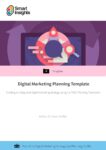Dr Dave Chaffey’s practical review of the marketing trends that will matter for B2C and B2B marketers in 2025
October 2025 update
My latest annual post recommending digital marketing trends to watch is now live, covering the new techniques and opportunities to look forward to in the year ahead. ✨ 🔮 📈 🚀
View my post on the top 2026 digital marketing trends.
Of course AI is the main game in town, but which aspects of AI should you be taking a look at from a strategic POV? I cover 5 top-level use-cases of using AI to support marketing.
But AI isn't the only game in town and I also look at the latest Gartner hype cycle, our updated Martech tools wheel and other opportunities to improve marketing across our RACE framework.
I’ve been writing reviews of the latest digital marketing innovations for well over 10 years now; spurred on since they seem to be helpful based on the comments on LinkedIn and when I present them. I hope that's because I try to keep them practical. They’re also a way to keep readers of my books in the loop during the gap between new editions. This last year we’ve published the Eighth edition of Digital Business and E-commerce Management and next year the ninth edition of Digital Marketing: Strategy, Implementation and Practice.
I guess, I must enjoy the challenge too, since for many years, there weren’t significant new trends, more of an evolution, but that changed last year with the growing usage of Generative AI which was the most exciting innovation of recent years. As we enter 2025, there are lots of new challenges for digital marketing that marketers will need to grapple with in the year ahead. More challenges than opportunities I would say...
As always, I’ll keep the predictions grounded in what’s happening now with the early adopters and research on adoption and trends including our Future of Digital Marketing report we've produced in partnership again with Technology for Marketing and eCommerce Expo. You can download the report at the end of this article.
We’ll review how AI is REALLY being used in marketing, digital maturity, Martech and the growth of the Zero Click Marketing concept. We'll start with the bigger strategic issue around how we manage digital marketing and then dig into which channel tactics are most effective towards the end.
This article was originally written in September 2025, but is updated to include some of the lastest trends during 2025 which are summarized at the end of the article.
Trend 1. Lack of a dedicated digital strategy
This is a long-standing trend, over the fifteen+ years we have been advising on and researching adoption of digital marketing planning, we have found the percentage of businesses without a planned approach has remained similar, suggesting there are significant barriers to integrating planning in organizations.
We still see nearly half (42%) of businesses don’t have a digital marketing strategy, but they are doing digital marketing.
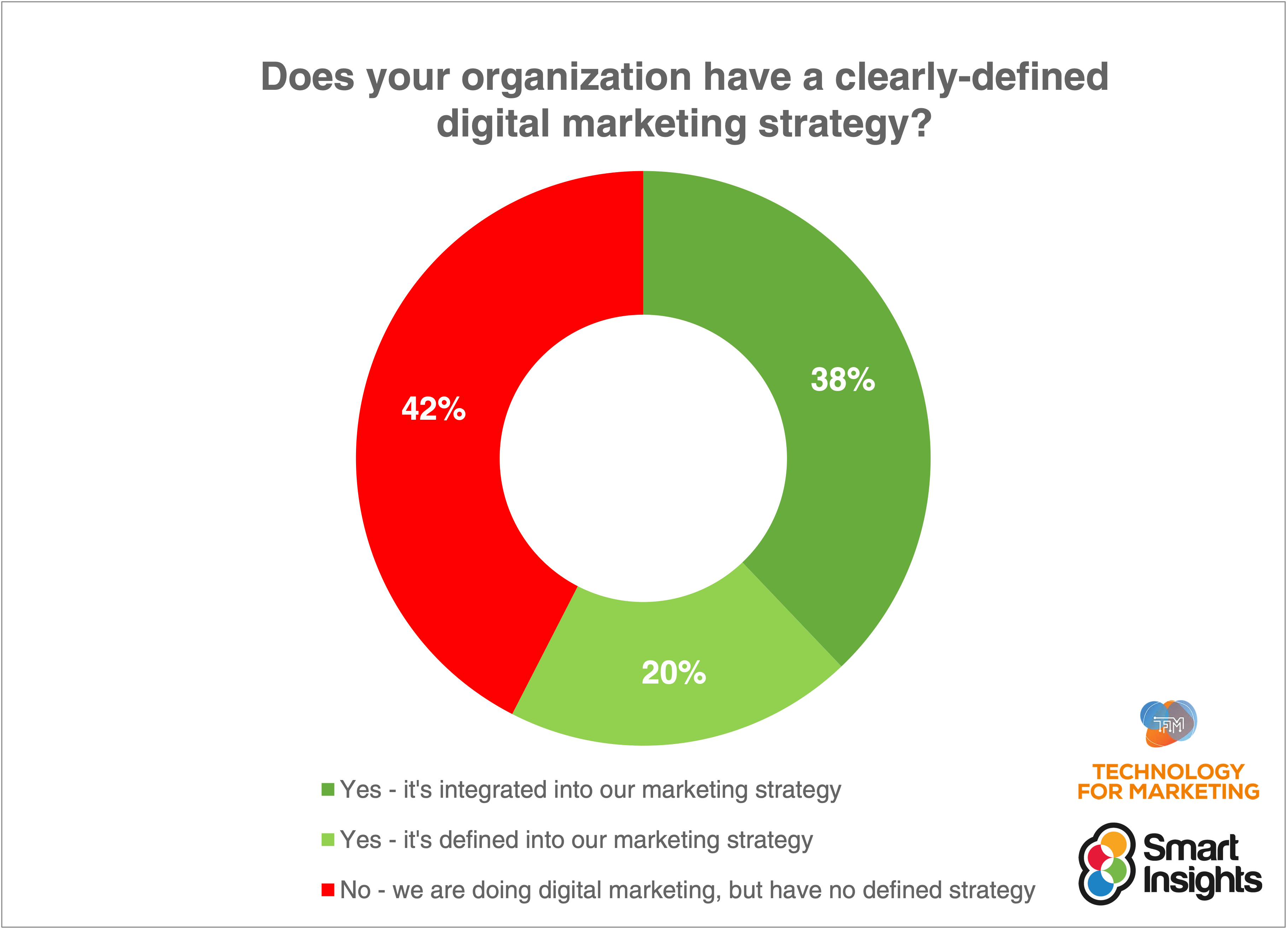
It’s good to see that more than half of businesses do have a strategic approach. The ultimate aim should be to use an integrated strategy, but it can be useful initially to have a dedicated digital strategy in larger organizations, or to plan for and make the case for investment in digital marketing before it becomes integrated.
To help with this challenge, around 2010 we defined the RACE Growth System for improving marketing effectiveness - learn more in this article on the RACE Digital Marketing Framework or download our free planning template.
Free digital marketing plan template
Our popular marketing planning template is structured across the Smart Insights RACE Framework. Join Smart Insights as a Free Member to download our digital marketing plan template today
Access the Digital marketing plan template
Action: How well-defined is our digital strategy and does it enable us to compete in the increasingly competitive digital channels. If the answer is No, then kick off a digital marketing audit which brings us on to...
Trend 2. Digital Maturity increases (slowly)
The previous chart is a symptom of a bigger malaise, which is a surprising lack of digital marketing maturity in many businesses. All this activity and investment is aimed at improving digital marketing capabilities, so in the research we asked where people were now with using digital marketing and where they would be in the future.
Results for businesses in our survey show that, across all pillars, around half of businesses are rated at lower levels of 1 to 2 (average 2.4) out of a maximum of 5 showing clear room for improvement. For context, for small and medium businesses with limited resources, we recommend that level 3 is a suitable aspiration to compete. For businesses who have a high digital contribution where online leads and sales are vital to their success, we recommend that levels 4 and 5 are necessary if the case for investment is made.
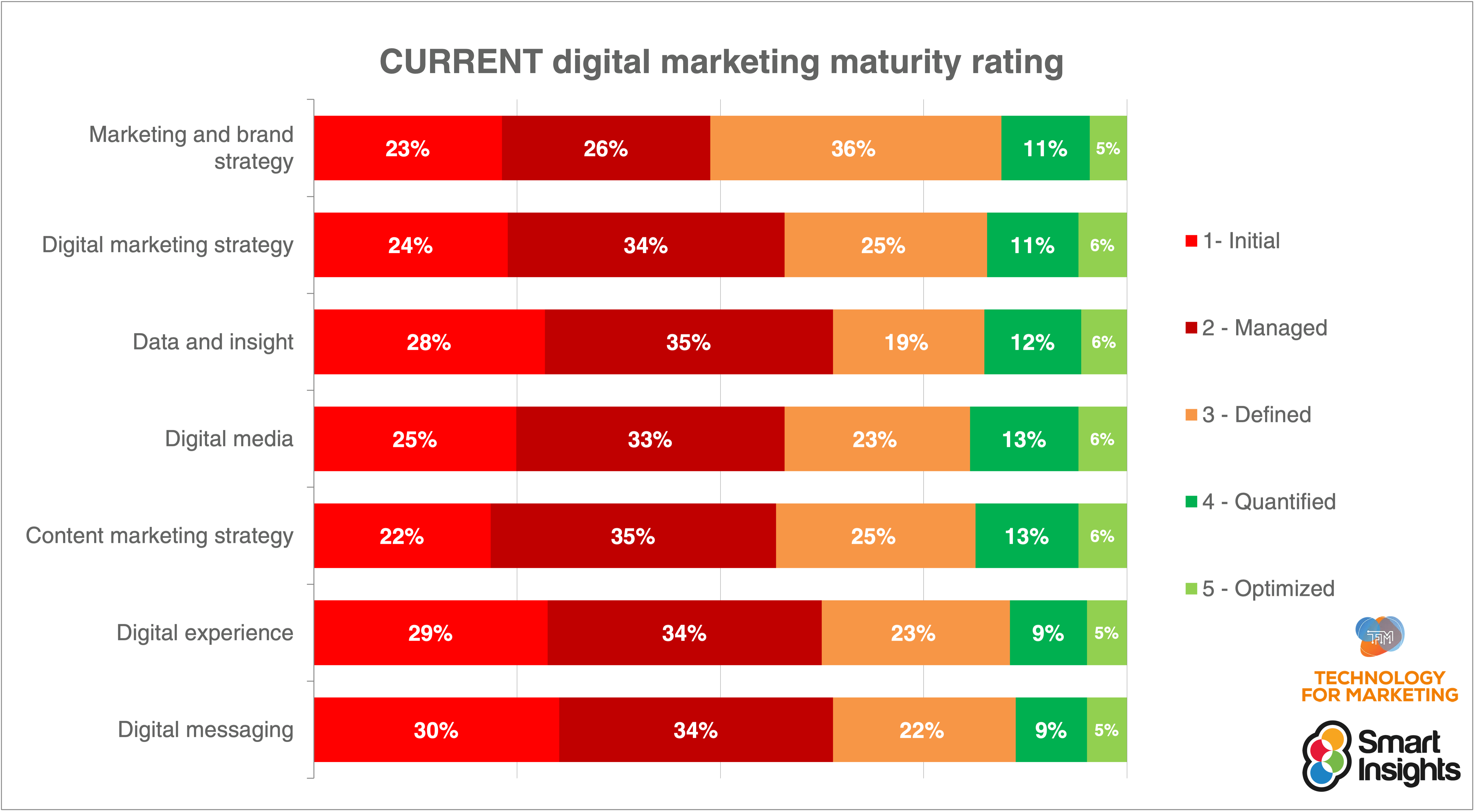
Next, to gauge how businesses are looking to improve their capabilities in the future, we asked respondents to repeat the analysis for 2025. The stark contrast between the two charts suggests that many of the businesses at levels 1 and 2 are conscious that they need to improve their capabilities and are planning to invest to achieve a higher-level in 2025.
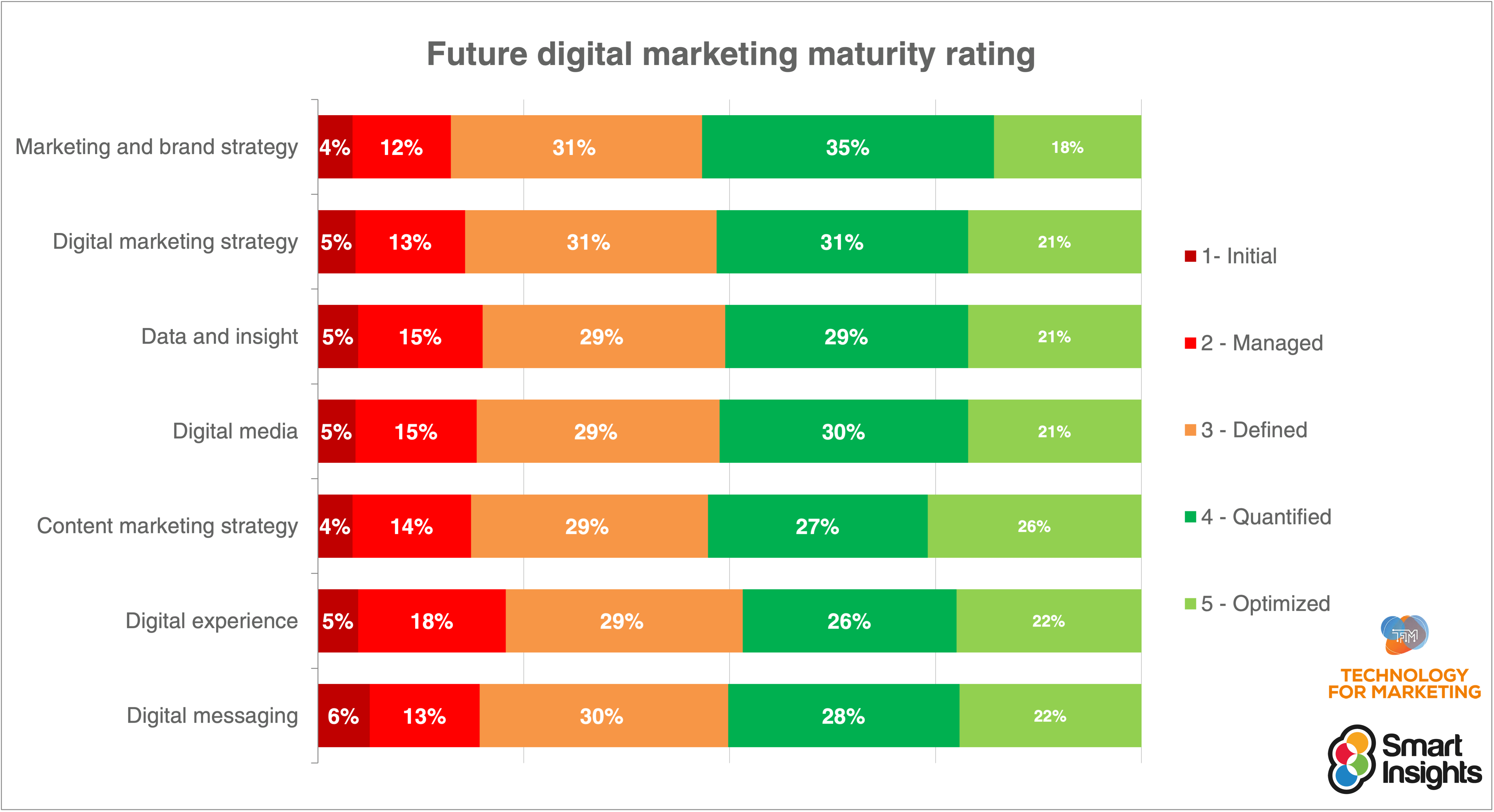
We expect the progression to be slower. Of course, it’s human nature to aspire to improve, but it’s likely that there will be barriers that prevent this degree of improvement for many businesses. No surprise, that lack of resource is the top barrier to improving, showing that 2025 should be about Smarter Marketing - another digital marketing management trend.
Action: Score your maturity across these pillars of marketing using our 10+ free visual digital benchmarking templates like those above. Prioritize your activities for the year ahead on the 3 with the greatest potential.
Trend 3. Standard Operating Procedures (SOPs) for Smarter Marketing
One aspect of Smarter Marketing is to stop reinventing the wheel if you can avoid it. We're an advocate of using SOPs to support improvement and efficiency and our RACE framework defines the SOPs that matter for digital marketing and uses templates that businesses can apply to their organization.
We didn't ask about SOPs in the main survey, but our LinkedIn poll suggests many are using them, but equally many aren't. I found out about them several years ago where they were being used in the United States applied to E-commerce. This is a great fit since there are many repeatable processes in an online retail store. I think they are less well known in the UK and Europe, but interest is increasing based on the popularity of the post below I wrote about them.
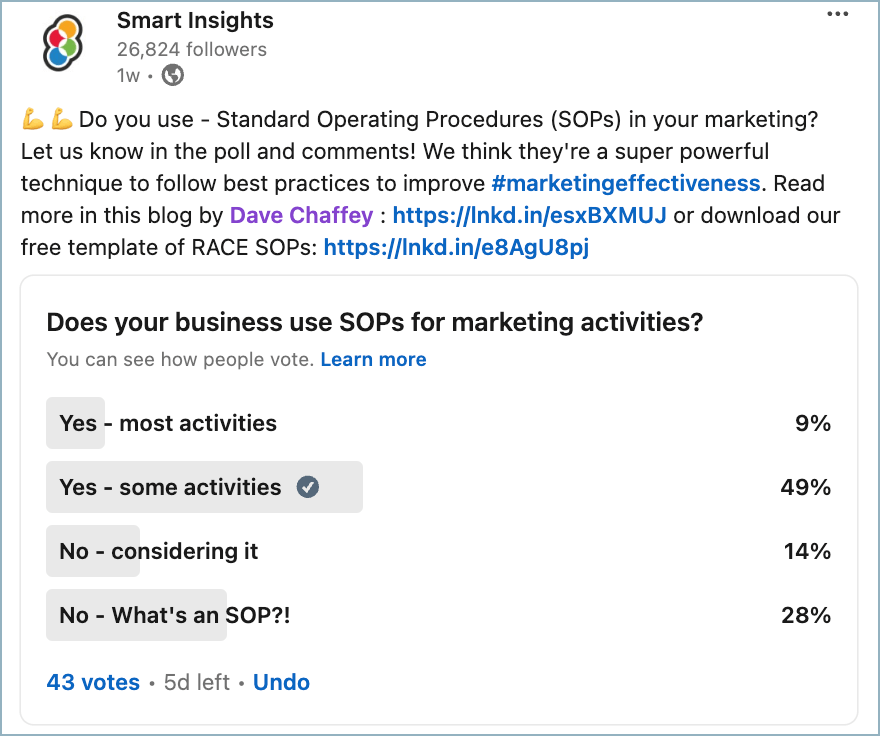
Action: Consider to what extent use SOPs to avoid 're-inventing the wheel' and to make day-to-day activities across organic and paid digital channels more effective.
To help businesses improve their maturity, Smart Insights RACE premium downloadable Docs and Sheets templates support 70 Standard Operating Procedures for Digital Marketing - read this briefing blog explaining how SOPs should cover both strategic to tactical channel activities to drive improvement.
Trend 4. Smarter Marketing fuelled by Gen AI
We have seen how resourcing is the biggest limitation in increasing digital maturity, so this is a driver of this trend which we can simplify to ‘doing more with less’. This is forced upon many by the competitive environment which means that less budget and people resources are available for marketing. This also links to the previous trend since Gen AI is a great fit for defining your SOPs and partially automating them.
Likely this trend has been accelerated by Generative AI since it provides a free tool that pressured marketers will often want to lean on proactively while their managers may be leaning on them to use it to increase their priorities. We have many guides on Smarter Marketing with AI on the site and a free cheatsheet available to Free members on using ChatGPT for marketing.
In our survey, we asked to see whether Generative AI was living up to the hype. I’m not sure whether it’s surprising or not, given that around half of the businesses we surveyed weren’t using GenAI at all. Are they to be congratulated for realising that the quality of their marcomms were fall or chastised for being behind the curve. I veer more to the latter unless they have tried it, but decided that it’s not ready for them yet.
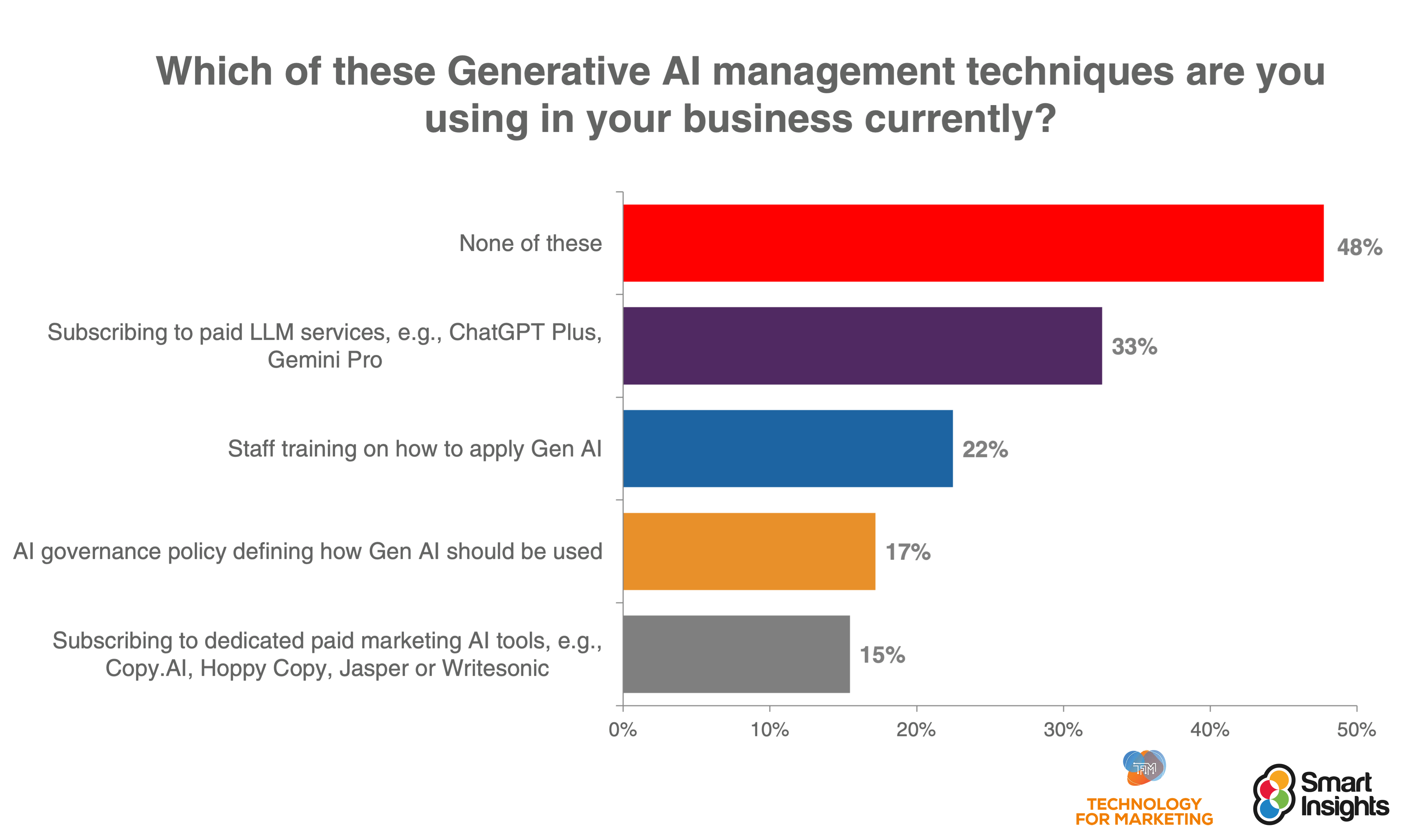
The research suggests to me that those who are using it should be chastized for how they are using it, either without training or an AI governance policy. Don’t they remember the GIGO acronym from tech pre-history?! We certainly believe controls are essential to maintain quality as we show in our AI for marketing governance policy template and article which wasn’t written by AI (apart from collaborating on the structure, an example of Smarter Marketing).
Action: Review whether you have a governance approach for Generative AI that defines which tools you use for which activities by which people and put in place checks to make sure AI isn't compromising your content quality.
Trend 5. The AI-assisted Marketer
This follows on, hot on the heels, from the previous Trend. In our report, we compare the popularity of the wide range of applications of AI in marketing, since AI can support the ‘AI-assisted marketer’ in so many ways beyond Generative AI for copywriting. For example, to support with planning and reporting. We were surprised by we ran on LinkedIn that showed that many were using it to support this process ans also to support analysis and reporting.
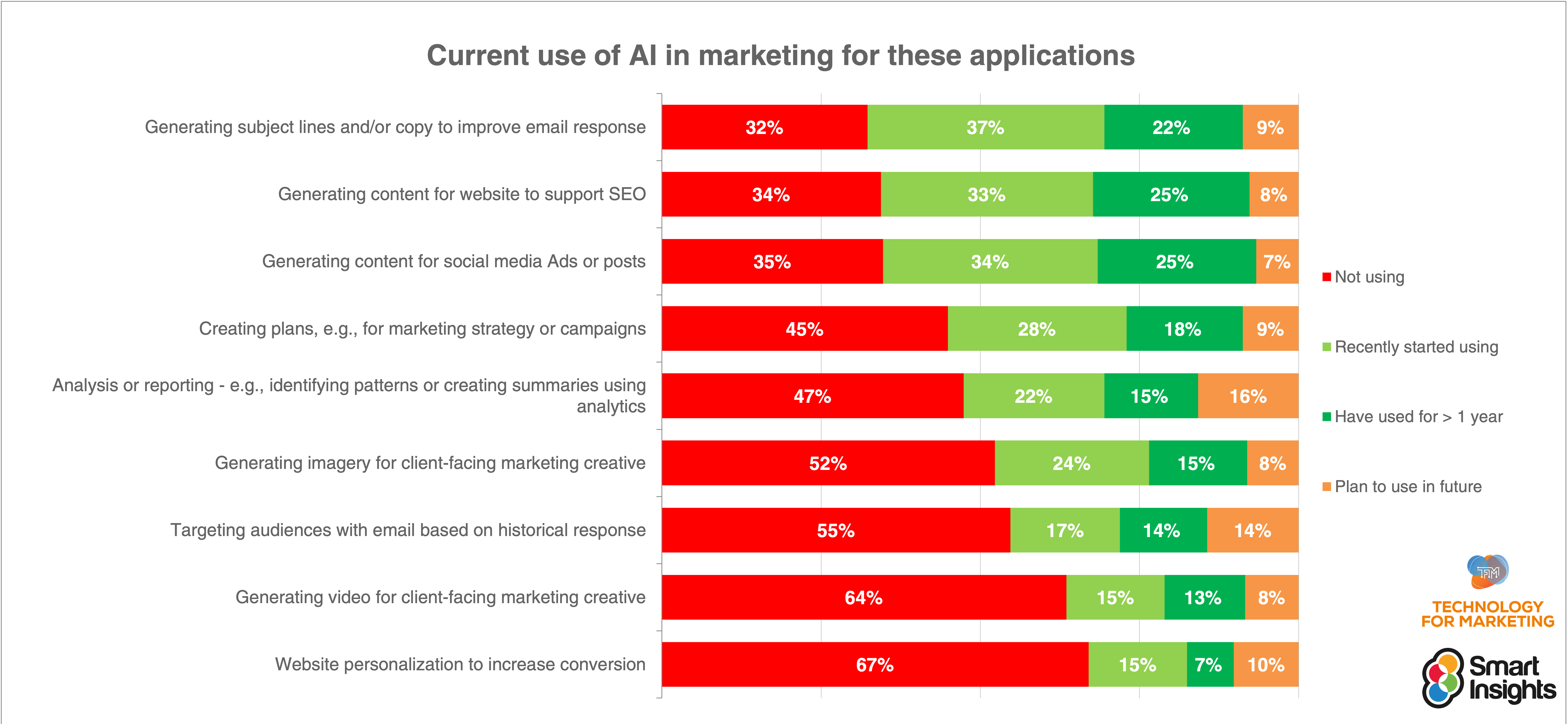
The most common applications of AI were, nevertheless, using it to support copywriting for email marketing, organic search and social media. Over one half of respondents were using it for these purposes.
Action: This also requires an AI Governance Policy or Playbook that is agreed for your business, even if you are a 'team of one'. Playbooks are also particularly important for agencies since their should be transparency between agency about what tools are used for and the quality control checks that in place.
Trend 6. Martech Composability
What’s that then you’ll be asking. I picked up the term from Martech guru Scott Brinker who said: “What an amazing time to be working in marketing and martech! Our entire industry is blossoming like the wildflower “super bloom” happening in California this spring, fed by the rain, rivers, and sunshine of generative AI, universal cloud data warehouses, and software composability”. Well, I’m not sure it’s that good, but what is composability. It’s essentially what we used to call interoperability in IT. It’s defined as:
“A software architecture pattern that allows organizations to build software systems from small, independent components that can be combined. This approach is different from traditional, monolithic solutions, which are often inflexible and have predefined capabilities”.
The importance of this is illustrated by two figures from Scott’s own research that shows the limitations of the monolithic cloud solution often bolted together from different tech acquisitions.
Although there is a trend away from CRM platforms to data-centred platforms such as CDPs and Datawarehouses…
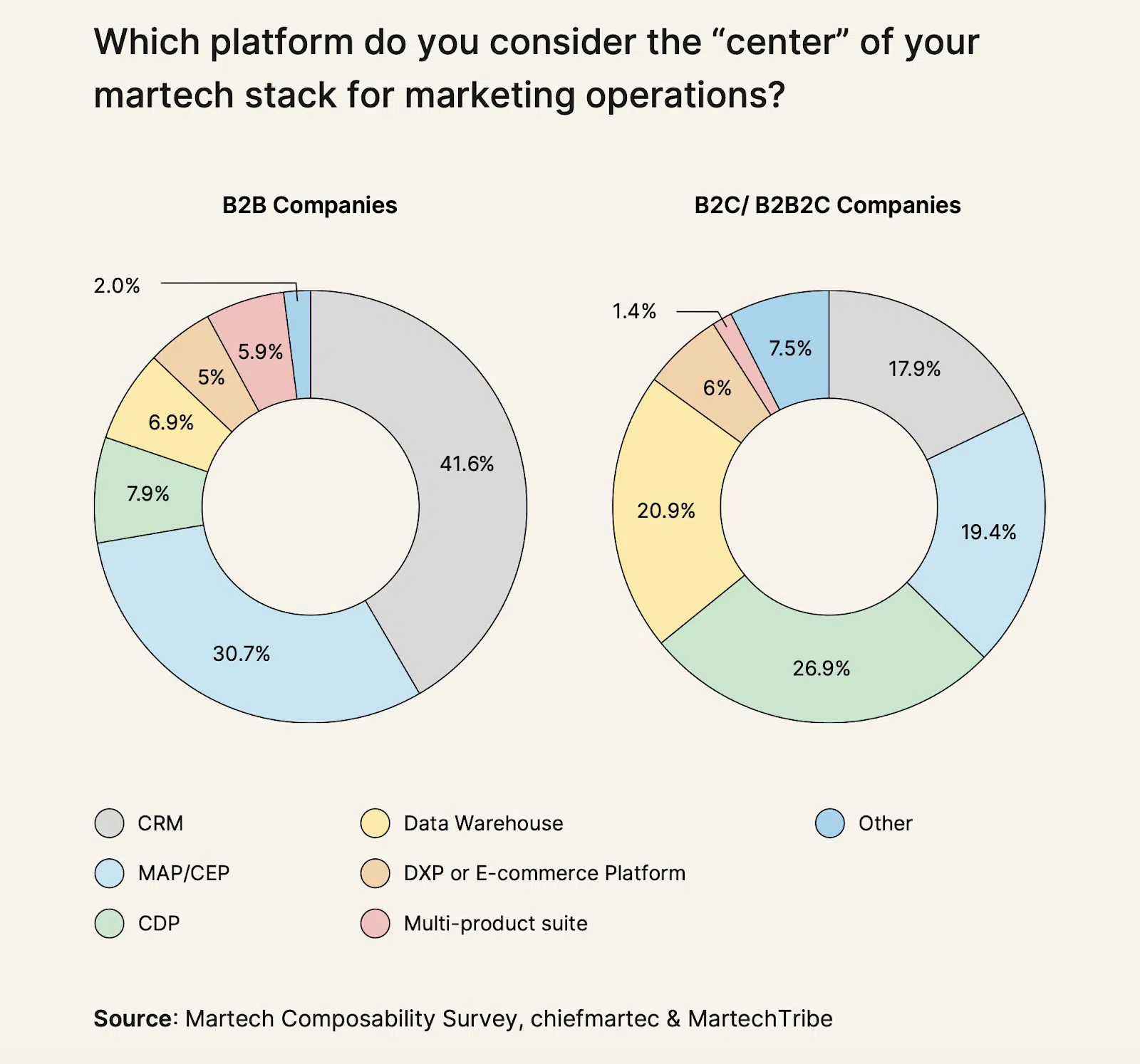
Regardless of the platform there is a problem that people are using other modules for core functionality for good reasons in the research like effectiveness, usability and functionality.
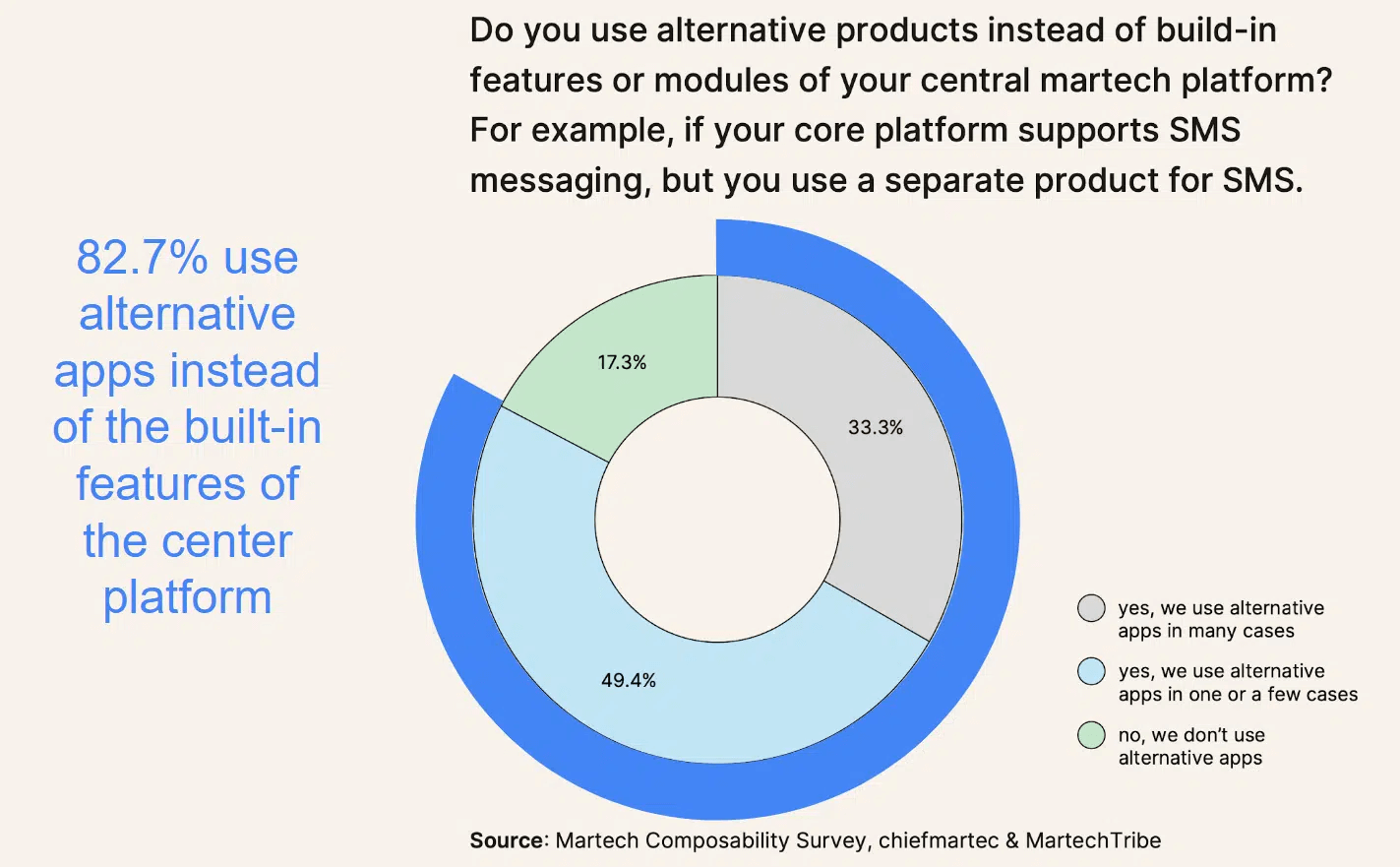
This alongside a trend that suggests that Martech’s bubble may have burst or rather there is more focus on Return on Martech. In the 2024 Gartner CMO Spend Survey it was found that in the larger businesses survey only 23.8% of marketer’s budgets have been allocated to marketing technology — the lowest recorded martech budget proportion since 2018. I disagree with the ‘only’ - it’s still a huge proportion particularly if you’re having to pay more than once for the same functionality.
Action: Review your Martech stack to see how it can be made leaner and better integrated. Refer to our digital marketing tools wheel to review which tools should be part of your stack across the RACE framework.
Trend 7. Zero click Marketing
If you have heard of this concept, it’s likely been via Rand Fishkin, ex of Moz and now of Sparktoro. Zero Clicks originally referred to the falling proportion of people clicking through from Google. Here are the latest figures from SparkToro which show us that for the keywords tracked, fewer than 60% of searches leads to a click on Google.
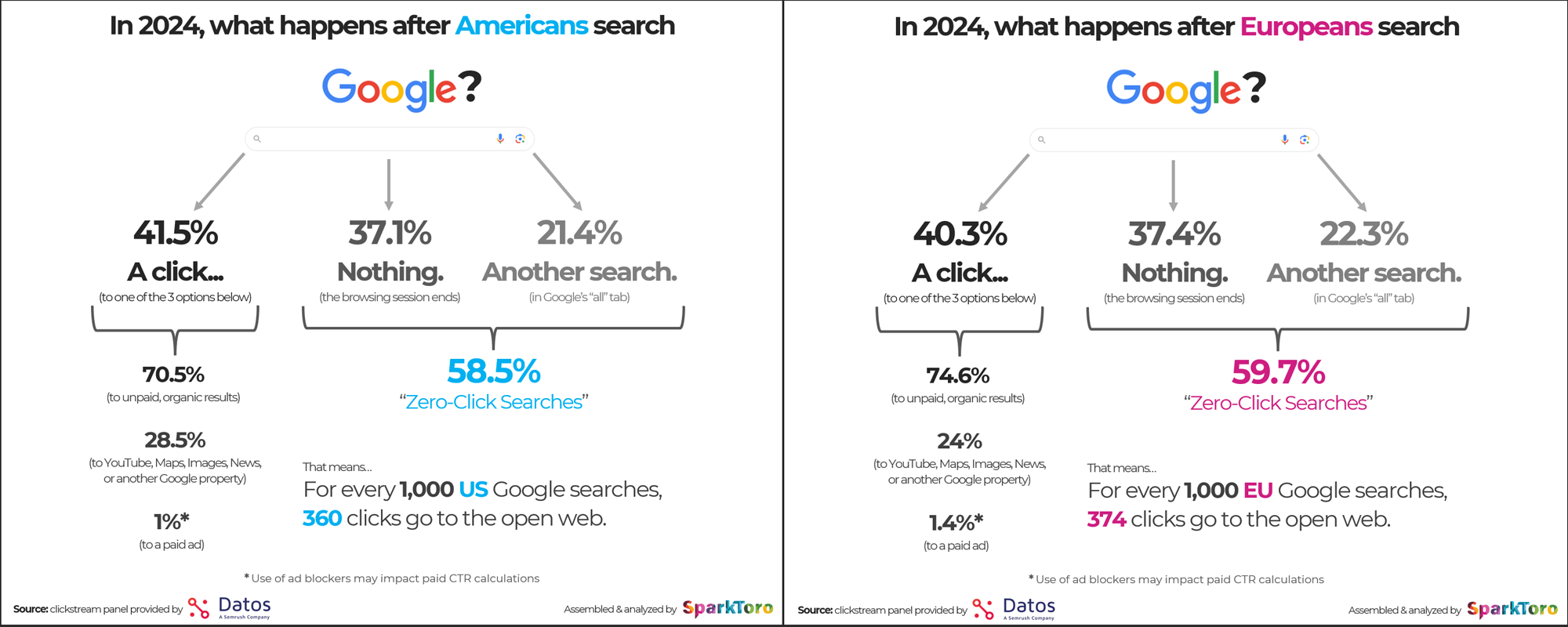
Previously this was because of the SERPs features such as the Related Questions rich snippets which according to Mozcast now feature in 90% of keyword searches they track. If people see the answer to their question on the SERP, then they won’t click through resulting in falling traffic to destination sites. As our next trend shows, AIOs have reduced this further.
More recently, the Zero click concept has been extended to other platforms such as social networks whose goal has always been to keep people on the platform. Rand has gone as far as to say:
"The Way We’ve Done Digital Marketing for 20 Years is Ending"
He is urging people to invest more in awareness-building, brand-building and PR and using content marketing as the main goal of content marketing (rather than SEO). It suits him to say this since SparkToro is an insights tool that can support you in these activities. I disagree that digital marketing is changing fundamentally, since using exceptional content marketing to support PR and SEO has always been an effective tactic. But, certainly there is a trend.
Amanda Natividad has taken this one step further by exploring the concept of Zero Click Marketing as an activity. I think this is taking it too far, but it’s useful to prompt people on where they should focus their activities to get success:
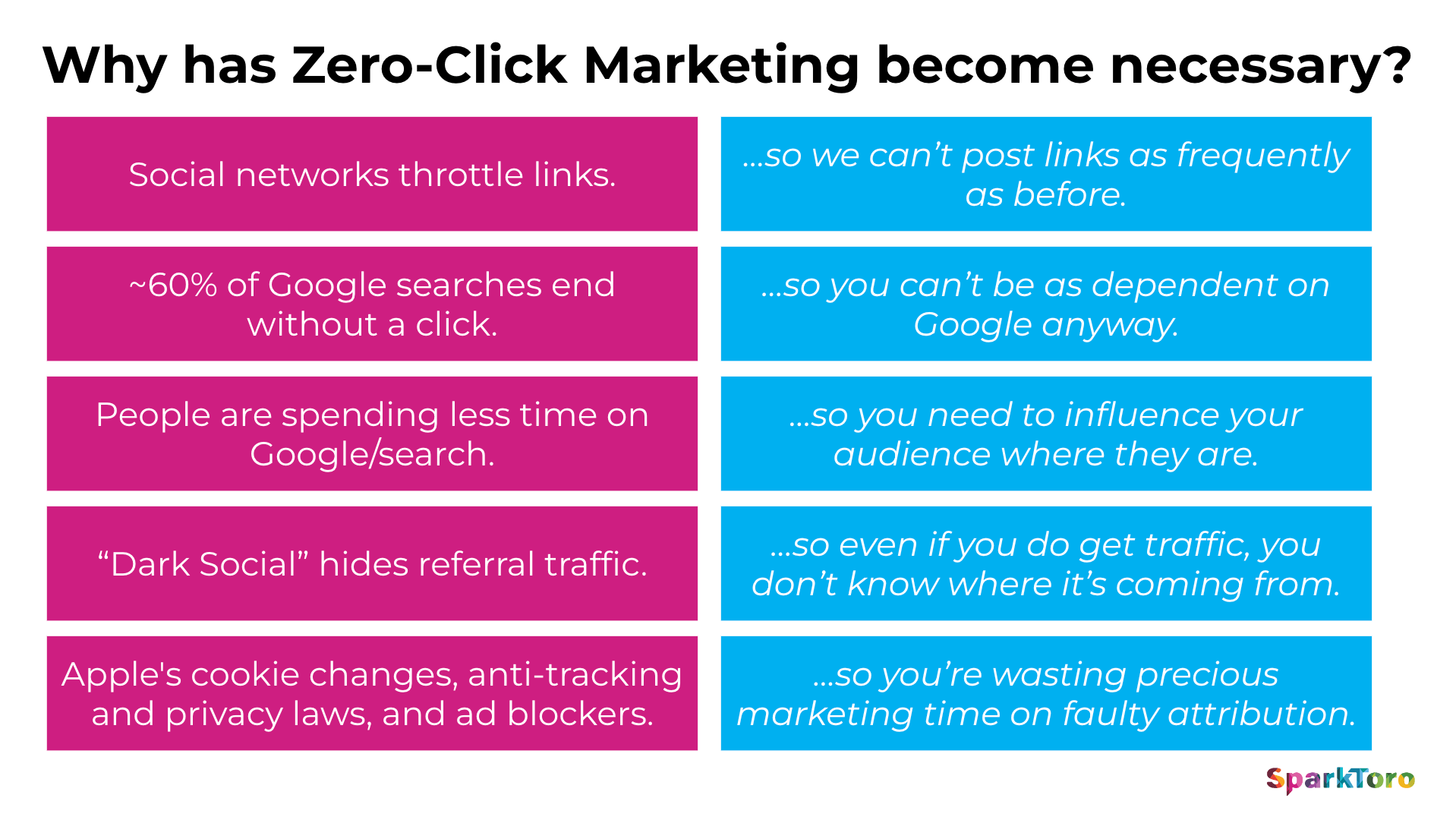
It’s only a brief post, but here’s a summary of the recommendations:
“Create marketing campaigns that people will actually care about — you know, optimize for those impressions so that people will actually see and be moved by your marketing”.
“Guide your decisions by the science of understanding people and the platforms on which they spend time. It’s uncovering audience behaviors, preferences, demographics, sources of influence, behavior, etc. and then investing wisely in the right places with the right content, using lift-based measurement to judge impact and choose where to double-down and where to pull back”.
“Accrue algorithmic capital by creating high engagement zero-click posts and and then use paid media e.g. retargeting to sending clicks back to your site”.
Action: Review the types of content and content distribution techniques you utilise, for example using our content marketing matrix. How does the quality of your content stack up against competitors. Ask is your content quality sufficient to inspire, differentiate your brand and encourage action?
Trend 8. Integrating AI into the SERPs and AI use reducing search use
AI generated results have featured in Bing for what seems like years now, but it’s only in mid 2024 that Google rolled out AIOs, which is SEO speak for Google’s AI overviews you see at the top of the SERPs. These seem likely to increase Zero Clicks, but it seems that many people do want further details, so it’s good that Google has recently ensured that recently, the recommended site for AIOs, not feature sites already in the top 5 (they were generally poor quality).
At the same time, we can imagine that the volume of searches will reduce if people are turning to AIs to answer their questions, particularly like Perplexity where that is providing a similar user experience to a search engine.
At the top-level, use of AIs doesn’t seem to be having a major impact, at least in terms of volumes of users:
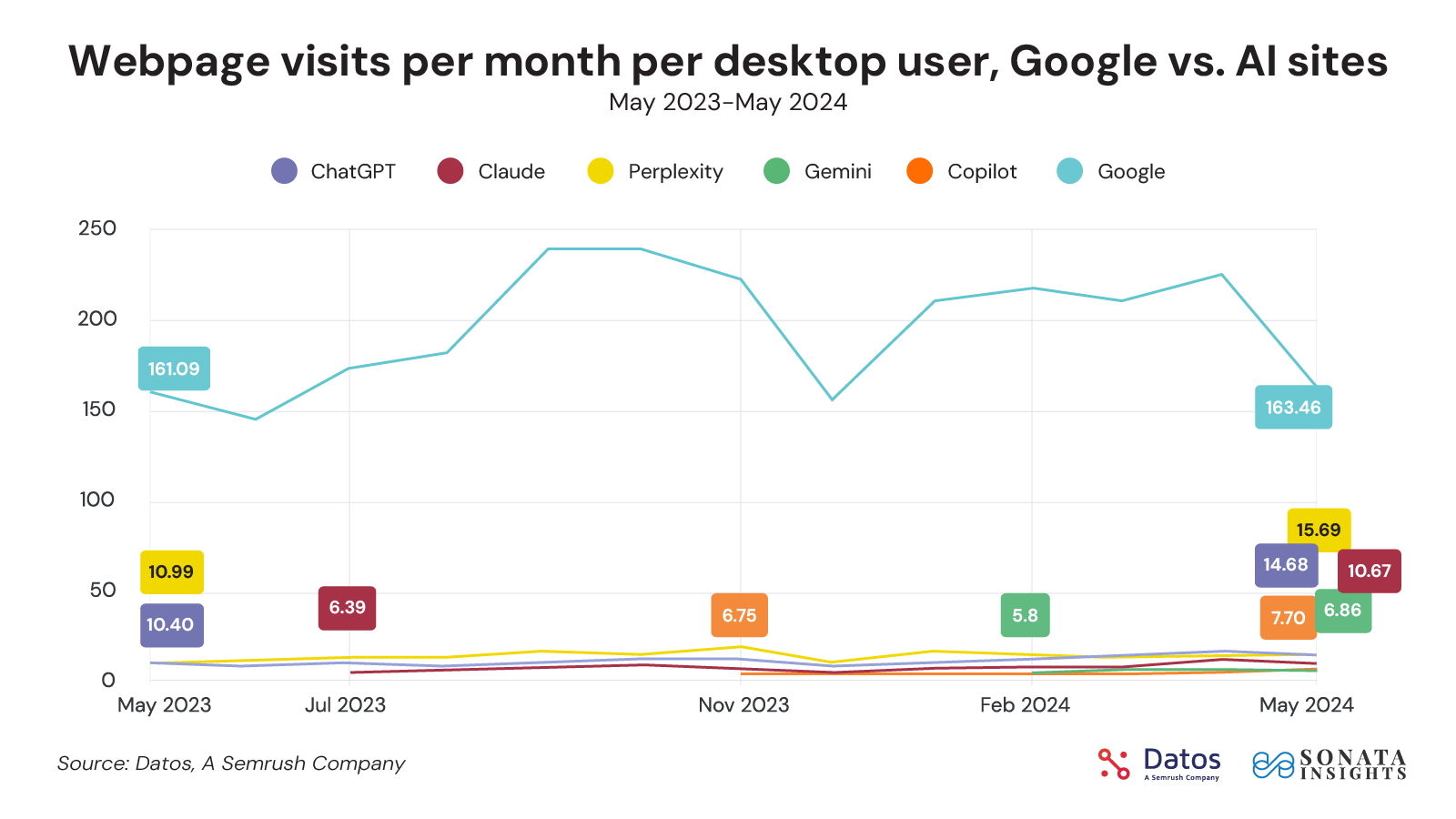
However, in certain niches such as programming, business and marketing the impact is likely to be much more significant.
Plus, with the July 2024 announcement that OpenAI will launch SearchGPT there will be an accelerating trend to replacement of traditional search queries by AI search queries.
Action: Specialist tools for reviewing the impact of AIOs in detail aren't available yet and Google is unlikely to add them to Google Search Console according to their comments, but you benchmark your standing against competitors for all the different SERPs features and use your existing reporting like GSC, Ahrefs, Moz, Semrush or Sistrix to check its effectiveness.
Trend 9. The ever-receding cookieless future
This is another long-standing one, that I think is difficult to get excited about unless you work in attribution or adtech. You will know that for many years, we have been promised a cookieless future. You maybe also spotted that Google announced in July 2024 that it will retain Third-Party Cookies in Chrome after years of planning alternatives….
This is contrary to plans dating back to 2019 when it launched the Privacy Sandbox heralding endless speculation and review of alternatives for the ‘Cookieless Future’. Instead, Chrome will offer users new options to manage their cookie preferences, while maintaining the Privacy Sandbox as a core part of its strategy.
This move is BIG news, since extending the use of third-party cookies will provide continued access to valuable data for targeted advertising. It’s good news, since techniques such as retargeting and conversion attribution are likely to be more accurate than the alternatives that were going to replace them. There will also be less immediate onus on businesses to understand and make changes, it’s a ‘stay of execution’. However, the trend remains and savvy businesses will use the time wisely to understand and select alternatives.
Action: Review your use of third-party cookies for compliance with privacy requirements
Trend 10. Digital Marketing Optimization still too hard for many
To assess the extent to which insight is used to test, learn, and improve the effectiveness of digital media, experiences, content and messaging, we asked marketers to categorize their approach to testing for each. There is a similar level of testing across all four of these pillars, but few have a continuous, structured program which is line with what we saw about maturity earlier.
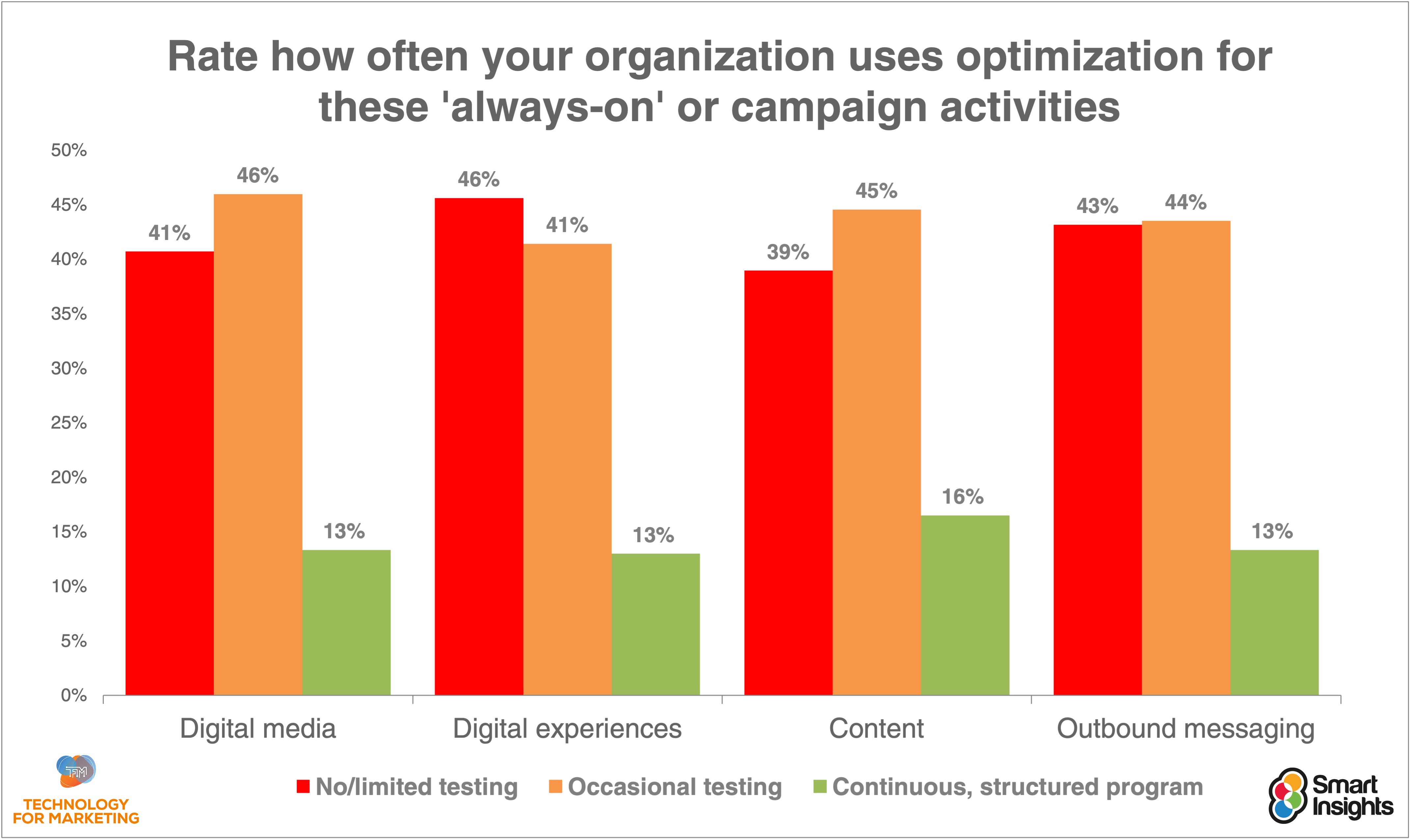
The standout finding from this chart is that a continuous, structured programme of testing is relatively uncommon, despite the often-touted benefits of digital media being ‘the most measurable’. Kudos to the fewer than 20% of companies that already have a continuous programme in place, and to those that at least test occasionally (around half of businesses)!
Action: Review how you can introduce a more structured approach to optimization, for example, using the RACE 90-day planning approach that Smart Insights recommend.
So, we're at 10, time for a bonus trend!
Bonus! Trend 11. Strategic Content Marketing
I remember when content marketing first became a concept we could anchor our digital marketing around and it has been fascinating to see how the adoption of content marketing play out. I think it’s a similar situation to digital marketing in that a dedicated strategy seems warranted given it’s important, but many don’t have it. It’s similar to the question we mentioned at the start of this review. Considering B2B where content marketing arguably has most focus, the latest research from the Content Marketing Institute (CMI) suggests that a dedicated strategy is rare, rather content marketing has become part of business-as-usual and seventy percent say their organizations integrate content strategy into the overall marketing sales/communication/strategy with around seventeen percent say using a stand-alone strategy for content marketing with only 9% say they don’t have a content strategy.
From a practical point-of-view, what types of content marketing are proving popular? The CMI research is useful for benchmarking. TBH, this leaderboard looks similar to what it would have 10 years ago, but Video content is significantly higher than in previous years, it has been gradually growing.
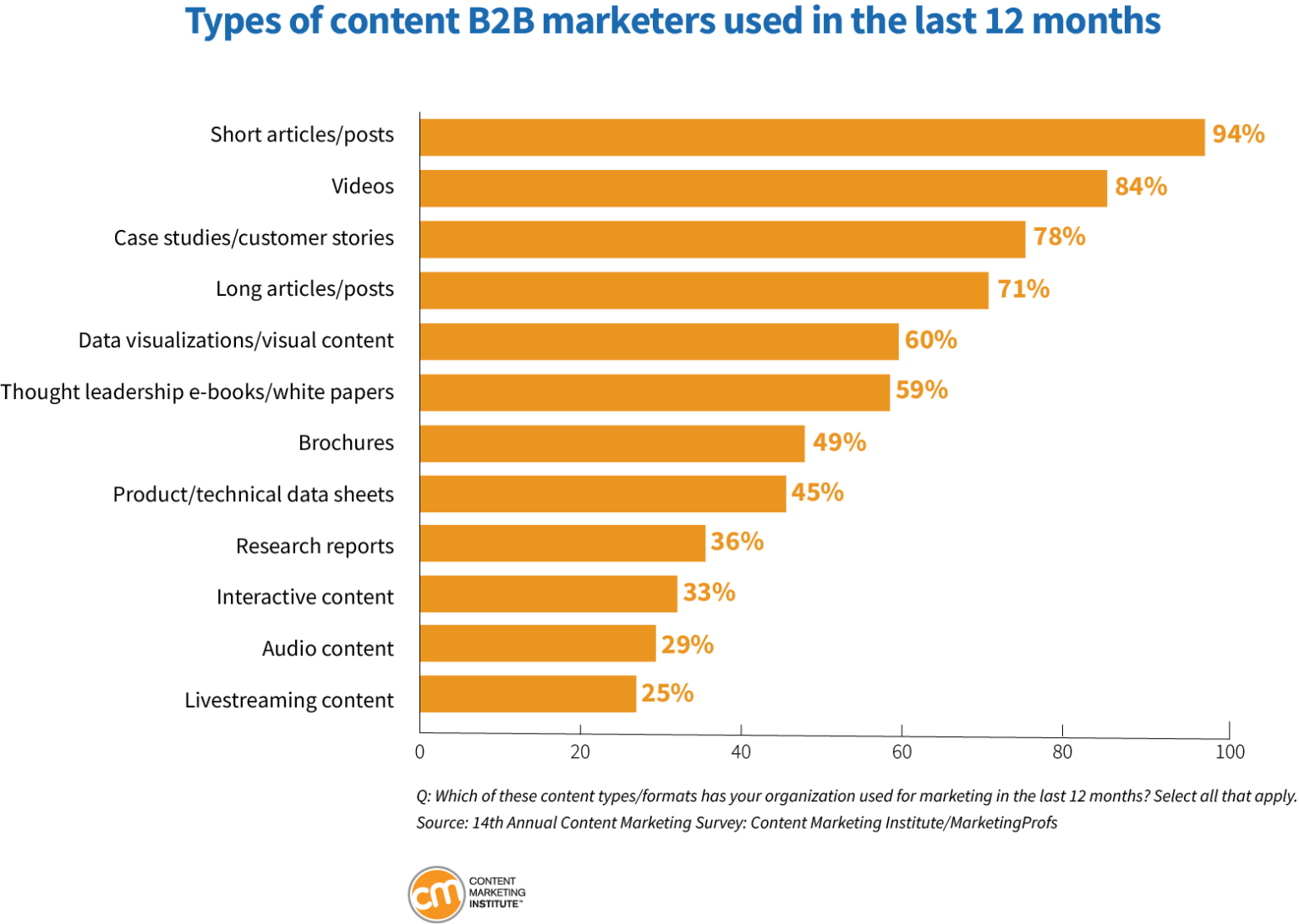
Action: Ask, do we need a better aligned, integrated content-marketing strategy? See our content marketing learning path course and templates for guidance an approach to systematically improve your content marketing effectiveness and ROI.
Summary. So which channels really matter?
You can see that in this review that many of the newer trends are around AI and Martech line. But let's go back to the top-level and think about marketing channels. Have the disruptive forces of AI and Zero Click Marketing really change the channels we know and love. Yes, it may be getting tougher to get traction in organic channels, but sorting the top-rated channels by those with Highest ROI shows that the top 4 are all organic. So many of our tried and tested content-based marketing techniques are still being made to work by many, at least those completing our survey.
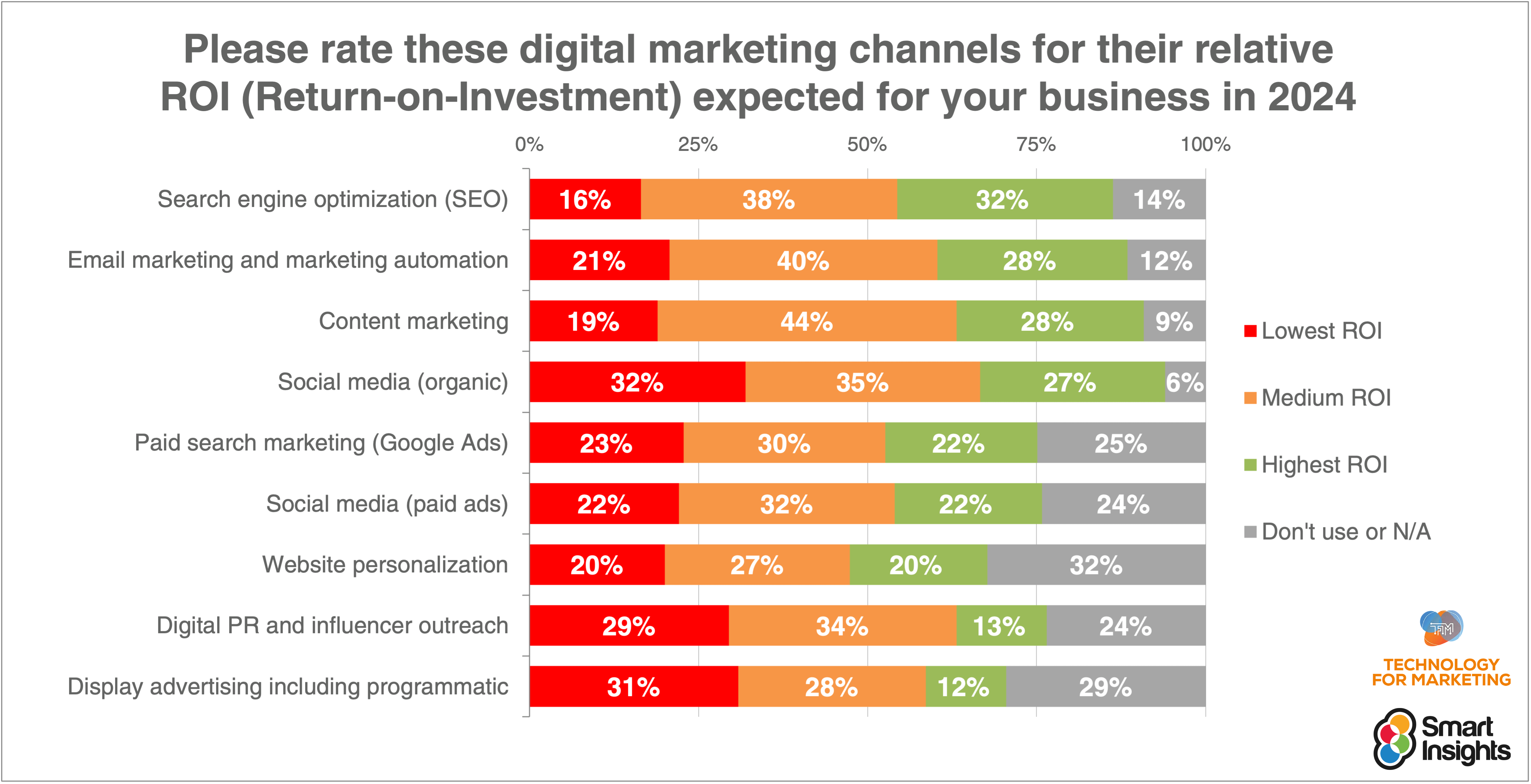
You can download the full report here:
Additional trends
These are covered in our other compilations of digital marketing stats including :
- Social media statistics 2025 - a compilation updated to included the latest figures on the growth of social network Bluesky which many X / Twitter users are migrating to.
- 2025 conversion rate statistics - our compilation of add-to-basket, conversion rates and other e-commerce KPIs to help create forecasts of online sales on different platforms



